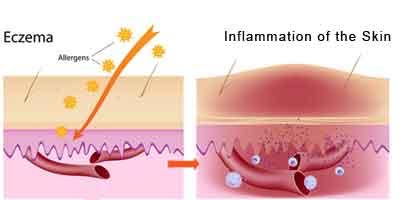- Home
- Editorial
- News
- Practice Guidelines
- Anesthesiology Guidelines
- Cancer Guidelines
- Cardiac Sciences Guidelines
- Critical Care Guidelines
- Dentistry Guidelines
- Dermatology Guidelines
- Diabetes and Endo Guidelines
- Diagnostics Guidelines
- ENT Guidelines
- Featured Practice Guidelines
- Gastroenterology Guidelines
- Geriatrics Guidelines
- Medicine Guidelines
- Nephrology Guidelines
- Neurosciences Guidelines
- Obs and Gynae Guidelines
- Ophthalmology Guidelines
- Orthopaedics Guidelines
- Paediatrics Guidelines
- Psychiatry Guidelines
- Pulmonology Guidelines
- Radiology Guidelines
- Surgery Guidelines
- Urology Guidelines
A new treatment approach for eczema?

Eczema affects about 17 percent of children in developed countries and is often the gateway to food allergy and asthma, initiating an "atopic march" toward broader allergic sensitization. There are treatments including steroid creams and a recently approved biologic but they are expensive or have side effects. According to a new study, a different approach to eczema, one that stimulates a natural brake on the allergic attack has been suggested.The new study has been published in Science Immunology.
The skin inflammation of eczema is known to be driven by "type 2" immune responses. These are led by activated T helper 2 (TH2) cells and type 2 innate lymphoid cells (ILC2s), together known as effector cells. Another group of T cells, known as regulatory T cells or Tregs, are known to temper type 2 responses, thereby suppressing the allergic response.
Yet, if you examine an eczema lesion, the numbers of Tregs are unchanged. Interestingly, Tregs comprise only about 5 percent of the body's T cells, but up to 50 percent of T cells in the skin.
"Our question was, is there something special about the Tregs that reside in the skin?" says Raif Geha, MD, chief of the Division of Immunology at Boston Children's Hospital and the senior author of the study.
Geha led an investigation using two separate mouse models of eczema, each recreating a separate pathway leading to allergic skin inflammation. The team purified Tregs from the animals' skin and blood and compared the genes they express.
Several genes were especially likely to be turned on in the skin Tregs. One encodes retinoid-related orphan receptor alpha (RORα), a transcription factor that itself regulates multiple other genes.
"We then used a genetic trick to remove RORα only from Tregs," says Geha. "Without RORα, allergic inflammation went crazy in both our mouse models."
The team saw a three-fold increase in the influx of inflammatory cells, and ILC2s and TH2 cells were at the center of the action.
Restraining allergic skin inflammation
Why did the Tregs stop working when RORα was removed? Geha and colleagues discovered that the cells made less of a receptor for a cytokine called TNF ligand-related molecule 1, or TL1A. TL1A is released by skin cells known as keratinocytes, and activates not only Tregs but also ILC2 and TH2 effector cells.
"The two kinds of immune cells are competing for TL1A," Geha explains. "If Tregs don't have this receptor, they can't 'see' TL1A. Not only are they not activated, but more TL1A is available to activate the effector cells. So you have a double whammy."
Testing human samples, the team documented higher expression of RORα in skin Tregs compared with those in blood, similar to mice.
Geha now wants to see if RORα is expressed less in human eczema and whether it's important in the atopic march. If so, he sees several possible treatment approaches.
One is to boost RORα's level or activity with compounds that act as RORα agonists, perhaps given in a topical cream. Geha's lab also plans to look for factors in the skin that drive RORα activity, which could present other targets for intervention. Finally, the study showed that RORα regulates the expression of several genes important for Treg cell migration and function; those pathways could be potential targets too.
For more details click on the link: Science Immunology, 2018; 3 (21): eaao6923 DOI: 10.1126/sciimmunol.aao6923
eczemafood allergy and asthmainflammatory cellslymphoid cellsScience Immunologyskin cellsskin inflammation
Source : Press ReleaseNext Story
NO DATA FOUND

Disclaimer: This site is primarily intended for healthcare professionals. Any content/information on this website does not replace the advice of medical and/or health professionals and should not be construed as medical/diagnostic advice/endorsement or prescription. Use of this site is subject to our terms of use, privacy policy, advertisement policy. © 2020 Minerva Medical Treatment Pvt Ltd